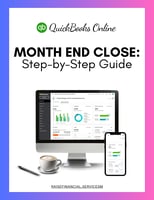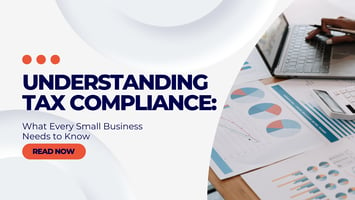Closing your books at the end of each month is a critical task for any business. It ensures your...
Understanding a Balance Sheet for Beginners: A Simple Guide
.png?width=231&height=347&name=Untitled%20design%20(5).png) If you're running a business or learning about finances, understanding the balance sheet is essential. This important financial statement provides a snapshot of a company's financial health at any given time. In this blog post, we’ll break down the basics of a balance sheet in simple terms, so you can understand what it is and why it matters.
If you're running a business or learning about finances, understanding the balance sheet is essential. This important financial statement provides a snapshot of a company's financial health at any given time. In this blog post, we’ll break down the basics of a balance sheet in simple terms, so you can understand what it is and why it matters.
What is a Balance Sheet?
A balance sheet is a financial statement that shows a company’s assets, liabilities, and equity. It is one of the most important documents for understanding a company’s financial position.
Think of the balance sheet as a picture of a business's finances at a specific moment. It shows what the company owns (assets), what it owes (liabilities), and how much the owners have invested (equity).
The Three Main Parts of a Balance Sheet
A balance sheet is divided into three sections: Assets, Liabilities, and Equity.
Let’s dive into each section.
1. Assets: What the Business Owns
Assets are anything of value that a business owns. These can be things like cash, property, equipment, and inventory. Assets are typically divided into two categories:
- Current Assets: These are assets that can be converted into cash within a year. Examples include cash, accounts receivable (money owed to the company), and inventory.
- Non-Current Assets: These are long-term assets that the company expects to hold for more than a year. Examples include real estate, machinery, and equipment.
The total assets on a balance sheet tell you how much the business has in terms of valuable resources.
2. Liabilities: What the Business Owes
Liabilities represent what a company owes to others. These can include loans, unpaid bills, or other financial obligations. Like assets, liabilities are also broken down into two categories:
- Current Liabilities: These are debts or obligations that the company needs to pay within a year. Examples include accounts payable (money the company owes to suppliers) and short-term loans.
- Long-Term Liabilities: These are debts that the company will pay off over a longer period, like mortgages or long-term loans.
Liabilities are an important part of the balance sheet because they show how much the company owes to creditors and others.
3. Equity: The Owner's Investment
Equity is the difference between assets and liabilities. It represents the value of the owner’s investment in the business. If you subtract liabilities from assets, the remaining amount is the equity.
Equity can come from two sources:
- Owner’s Equity: This is the money that the owner(s) has put into the business.
- Retained Earnings: This is the profit that the company has made over time and kept instead of paying out as dividends.
The equity section of the balance sheet shows the net worth of the company from the owner’s perspective.
The Balance Sheet Equation
The balance sheet follows a simple formula:
Assets = Liabilities + Equity


This equation must always balance, which is why it’s called a balance sheet. If it doesn’t balance, there might be a mistake in the financial records.
For example, if a company has $100,000 in assets and $60,000 in liabilities, the equity would be $40,000.
Why is the Balance Sheet Important?
The balance sheet is important because it helps business owners and investors understand the financial health of a company. It shows if the company has enough assets to cover its debts, how much it owes, and the value of the owner’s investment.
Key Terms to Remember
- Assets: What the business owns
- Liabilities: What the business owes
- Equity: The owner's investment in the business
- Current Assets and Liabilities: Short-term resources and debts (less than a year)
- Non-Current Assets and Liabilities: Long-term resources and debts (more than a year)
How to Read a Balance Sheet
Reading a balance sheet is easier than you might think. Start by looking at the total assets—this is everything the business owns. Next, check the total liabilities—this is what the company owes. Finally, look at the equity—this shows the owner's investment.
If the company has more assets than liabilities, it’s in a healthy financial position. If the liabilities are larger than the assets, the business might be in trouble.
Conclusion: Mastering the Balance Sheet
Understanding a balance sheet is key to running a successful business or making smart investment decisions. It’s a simple tool that shows a lot of valuable information, such as what a business owns, owes, and how much the owners have invested.
By learning how to read a balance sheet, you can gain deeper insight into the financial health of a company. With this knowledge, you can make better financial decisions, whether you’re managing a small business or investing in one.



